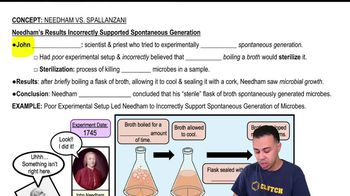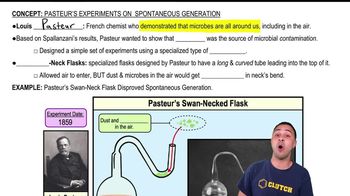Here are the essential concepts you must grasp in order to answer the question correctly.
Spontaneous Generation
Spontaneous generation is the discredited biological theory that living organisms can arise from non-living matter. This idea was prevalent before the development of modern microbiology and was used to explain phenomena such as the appearance of maggots on decaying meat. Understanding this concept is crucial for analyzing historical debates in microbiology regarding the origins of life.
Recommended video:
Introduction to Spontaneous Generation
Experiments of Needham
Lazzaro Spallanzani and John Needham conducted experiments in the 18th century that contributed to the debate on spontaneous generation. Needham's experiments involved boiling broth and then sealing it, which he claimed still produced microbial life, suggesting that life could arise spontaneously. His findings were pivotal in supporting the spontaneous generation theory, despite later criticisms and experiments that challenged his conclusions.
Recommended video:
Pasteur's Contributions
Louis Pasteur is renowned for his experiments that disproved spontaneous generation. Through his swan-neck flask experiment, he demonstrated that microorganisms in the air were responsible for contamination, not spontaneous generation. Pasteur's work laid the foundation for germ theory and established the importance of sterilization and aseptic techniques in microbiology, fundamentally changing our understanding of microbial life.
Recommended video:
Pasteur's Experiments on Spontaneous Generation
 Verified step by step guidance
Verified step by step guidance Verified Solution
Verified Solution



 3:53m
3:53m